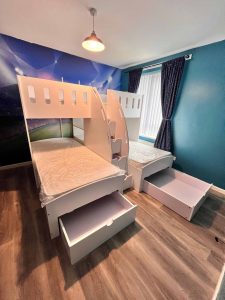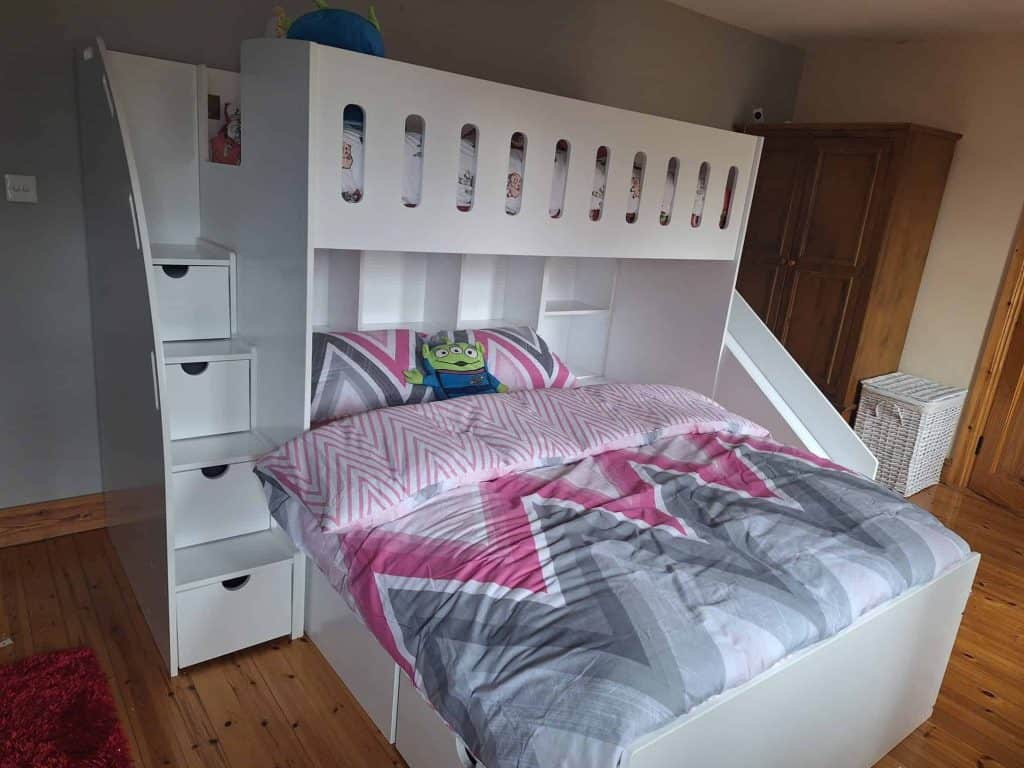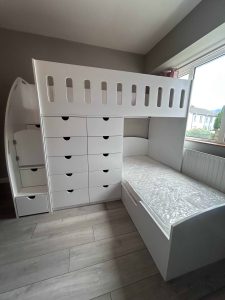
Triple Bunk Beds for Dormitories and Hostels: Practical Solutions for Student Housing
Finding the right kind of bed for hostels can be challenging when you want to provide comfort to the residents while saving space. 3 bed

Bunk beds have always been a great furniture option to maximize room space. 2 and 3 beds in 1 bunk are the favorite furniture for parents of children sharing a room. Why? It’s because triple bunk bed and mattress combinations are versatile and space-saving. Double and triple bunks save plenty of space to leave room for other storage and furniture. But besides the bunk bed, the mattress is critical to a comfortable sleep.
Certain mattress qualities are vital to ensure kids’ comfort and safety on the bunk. Discussing these features in detail will make the bunk bed mattress search easier for parents. Before we dive into the buying guide, first have a look at the type of mattresses that are suitable for bunk beds,
The most common mattress for bunk beds is memory foam. It provides excellent comfort and hugs your body like it is made just for you. The soft foam and its ultimate support help relieve pressure points as soon as your body touches the bed. Memory foam is the quietest option available for bunk beds at MK Furnishings. And lastly, it is lightweight, which helps manage the maximum weight limit of the bunk better.
A latex mattress is the best eco-friendly choice for a triple bunk bed and mattress combo. Latex is durable, firm yet comfortable, and provides enough support for the body. However, latex mattresses are low profile and heavier than many other mattress types. Thus, they are more suitable for bottom bunks.
Innerspring mattresses have metal coils/springs, making them plush and bouncy. It is comfortable and has excellent support for the body, but it is a little squeaky, especially when the kids enjoy playing and bouncing on it a lot.
Innerspring is affordable for bunk beds and heavier than many mattress types. So, its weight and bouncy nature make it a better option for the bottom bunk of a full-size triple bunk bed.
Now that you know the types of mattresses for bunk beds, let’s see what aspects parents must consider before buying mattresses for bunk beds.
Following are the factors you should consider while purchasing bunk bed mattresses,
Comfort is the most important thing when looking for a mattress. A plush yet not bouncy, light but not thin, and quiet mattress is the best for a bunk bed. Which triple bunk bed and mattress duo is this?
Memory foam is the most comfortable, lightweight, and quietest mattress for a single and triple bunk. You can also use a latex or innerspring mattress on the bottom bunks to allow kids to bounce, jump, and play without putting their safety on the line.
Measuring the size of the triple bunk bed and mattress is crucial for children’s safety. Children love to play and bounce on their beds, and a wrong-sized mattress risks their safety. Smaller mattresses leave bed sides open, which can hurt the kids. At the same time, bigger mattresses are more dangerous for the top bunk of a full-size triple bunk bed.
When the mattresses fit right in the beds, there is no room to hurt the kids. Take a measuring tape and make sure to measure the bed sizes correctly to get the perfect-sized mattress.
When choosing a mattress for triple beds, consider the maximum weight limit of the bunks. Lighter mattresses, like memory foam, are ideal for triple bunks. It allows you to sleep conveniently in the top bunk without worrying about going over the weight limit.
While talking about mattress thickness, it is important to mention that mattresses specifically made for bunk beds are thinner than regular mattresses. However, you must consider the position of the bunks while buying mattresses.
Get a thicker mattress for the top bunk, while thinner mattresses for the middle and lower bunks and ensure maximum headspace for the kids. Also, trundle beds need even thinner mattresses for hassle-free pulling out.
Measure the guardrails on the middle and top bunks to ensure the mattress sits at least 15-16 cm below the safety guard’s height, keeping the kids safe from falls.
When searching for a mattress for a 3 beds in 1 bunk, look for a firmer mattress if you are buying it for the kids. Kids prefer a firm mattress to a softer one because it lets them play freely on their beds. In contrast, adults and teens using a bunk bed will likely prioritize a softer mattress to help pressure points.
What is the difference between bunk and regular mattresses?
Bunk bed mattresses have a different profile than standard mattresses as they are specially made for bunks. They are thinner than regular mattresses to ensure a safe height distance from the safety guardrail. Plus, the lower profile maximizes the headspace for the bottom and middle bunks.
How often should you change your bunk bed mattress?
It is ideal to change bunk bed mattresses in 6 to 8 years. However, the bunk mattress replacement can vary based on different factors, including the quality and type of mattress. For instance, a high-quality mattress may easily go 10 years+ without requiring a replacement. Also, how often you use the mattress affects the mattress’s life.
Can I use the regular mattress on a bunk bed?
Yes, you can use a standard mattress for bunk beds. However, when buying a mattress, consider the measurements and safety features of the bunk bed. Ensure that the height and length don’t exceed the maximum limit for children’s safety.
Finding the perfectly fitting triple bunk bed and mattress pair can be hectic, but it is simple enough. Choose the type of mattress for a trundle or full-size triple bunk bed, considering the comfort, thickness, and weight you’re seeking in the mattress. Always prioritize the safety of the kids, especially the one sleeping on the upper bunks.
Contact MK Furnishings to find the most suitable mattress for your needs.

Finding the right kind of bed for hostels can be challenging when you want to provide comfort to the residents while saving space. 3 bed

Parents always seek ways to create a healthy environment for their kids to thrive. And our mission is to provide parents with insights into how

Unit 5 122 Battlehill Road BT61 8QJ Richhill





© Copyright by MK Furnishings Kids Beds